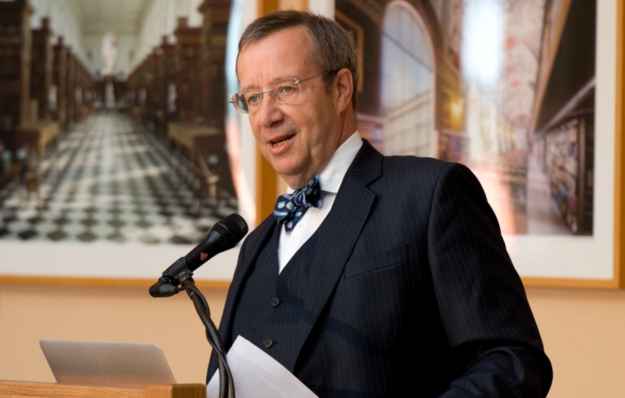 President Ilves speaking at Green Library, Stanford University. Photo credit: Steve Castillo
President Ilves speaking at Green Library, Stanford University. Photo credit: Steve Castillo
by Gabrielle Karampelas
As part of his official visit to the United States, President Toomas Hendrik Ilves of the Republic of Estonia visited Stanford University on Friday, May 23 to speak about “Evolving into a Genuinely Digital Society.”
Former U.S. Ambassador to Russia and Stanford Professor Michael McFaul introduced President Ilves, noting how fitting it was that a lecture about building a digital society be delivered in Silicon Valley by a head of state who learned computer programming at the age of thirteen.
Considered by many to be the technology epicenter of Europe, Estonia has become a source for entrepreneurs and innovation. The country produces more start-ups per capita than any other European nation, most notably Skype, which started near the country’s capital of Tallinn more than ten years ago.
“We are fortunate to have the opportunity to welcome distinguished guests, such as President Ilves, to Stanford,” said University Librarian Michael Keller, who hosted the event in the Cecil H. Green Library. Keller described a recently launched collecting initiative focused on Estonia and the appointment in 2013 of Liisi Eglit, assistant curator for Estonian and Baltic stu-dies, both made possible by gifts to the Stanford Libraries.

The event was lively and well attended by nearly 200 guests, including students, faculty and the greater community with an interest in learning first-hand how this small country, which is one-tenth the size of California, has become a leading tech nation.
The biggest risk to a digital society, according to President Ilves, is the absence of a secure digital identity on the web. “If you don’t have a safe digital identity, you don’t have security in the digital society,” President Ilves said.
President Ilves showcased the Estonian personal identification card and its “hyper secure” two-layer identification system as a solution his country pursued to “guarantee that you know with whom you’re communicating online.”
Widely used by Estonians, the ID card also grants secure access to vote online. President Ilves showed a brief video that demonstrated how the ID card authorizes transactions. Examples included items that a traditional penned signature would typically authenticate, such as bank and medical activities. An impressive 99% of prescriptions in Estonia are processed digitally.
Even with the successful results of Estonia’s efforts, President Ilves was quick to note that what has worked in Estonia may not be a solution for others.
“Estonia’s model for a strong digital society is having a secure identity, distributed architecture for safety, and laws ensuring that citizens own their own data,” he said.
A strong legal basis, according to President Ilves, is just as needed as a digital infrastructure in order for a wired society to function. “It’s equally important that we turn our attention to cyber security, to ensure the protection of people and data,” he said.
The lecture was cosponsored by the Stanford Libraries, the Department of Communication, The Freeman Spogli Institute, and European Entrepreneurship & Innovation @ Stanford Engineering.
If you were unable to attend the event, a recording of the lecture is available on the Libraries’ YouTube channel.














